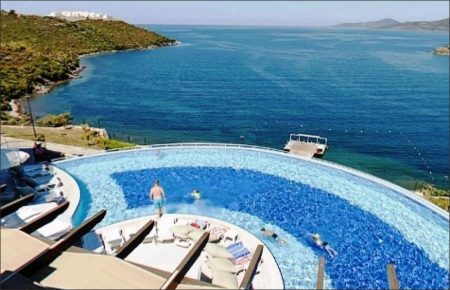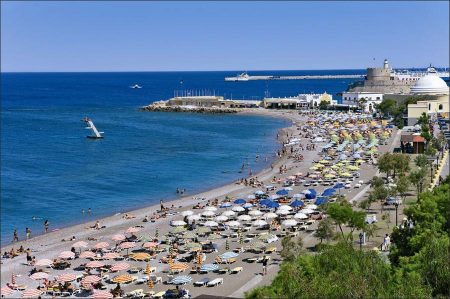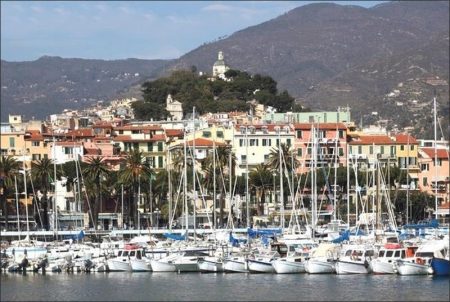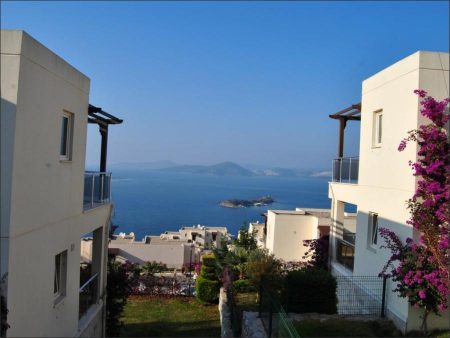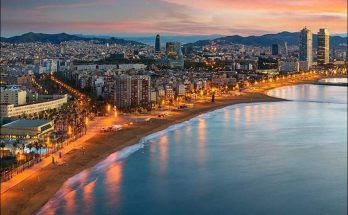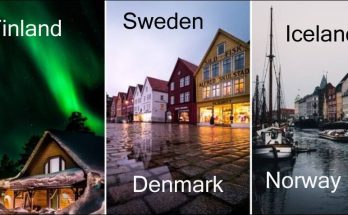Quiet islands, Venetian harbours, sumptuous seafood and golden sands … these seaside towns in France, Spain, Italy, Croatia, Greece and Portugal are ingrained with the spirit of summer.
Šibenik, Croatia
It’s known as the gateway to Krka national park and the Kornati islands, but this 1,000-year-old city has enough in itself to keep visitors happily busy for days. A slow amble along its waterfront goes past bars, restaurants and the 15th-century Cathedral of St James, a Unesco world heritage site with a blend of gothic and renaissance architecture. In the labyrinthine old town are several of Šibenik’s fortresses, including Sveti Mihovila, a magical spot for outdoor concerts in summer. There’s also the newly renovated Barone fortress, which has stunning views. Cool off at Plaža Banj, a pebbly blue-flag beach north of the old town.
Zadar, Croatia
With a fascinating Roman, Byzantine and Venetian history, laid-back beaches, a shimmering promenade and audacious public art, Zadar is instantly beguiling. Among its attractions is Nikola Bašić’s underwater art installation, Sea Organ, with its mournful sounds and disco dancefloor-like Greeting to the Sun companion piece.
Then there are the remains of the Roman forum and the imposing ninth-century St Donat church and wonderful Venetian marble lanes and stone houses. You can dive into the sea from the promenade or walk 15 minutes south to the pebbly Kolovare beach. For old-fashioned seaside atmosphere, head north along the coast to the Borik and Diklo beach resorts. The town is a great base for day trips: to islands, like Dugi Otok (from £6, 1½ hours, jadrolinija.hr), one of the loveliest in the Zadar archipelago; and glorious national parks such as Paklenica.
Sanremo, Italy
Called City of Flowers for its bloom-laden streets, Sanremo is Italy’s Monte Carlo – with a grand 1905 casino but not Monaco prices. It’s popular with families, and in true Italian style most beaches charge for entry. However, there is a spiaggia libera in the centre, off Corso Trento Trieste, and it’s fun to take the trolleybus (filobus, line U) west to the free beaches of Bagni Azzurri and Tre Ponti. Sanremo’s atmospheric old town, called La Pigna, is a warren of covered alleys, steps and little squares.Where to eat/drinkOn the main road behind the marina, Basilico e Pinoli does excellent coffee and breakfasts, with lots for vegetarians and vegans. At Osteria Camelot – in an 18th-century house at the foot of La Pigna – try octopus carpaccio (€10), swordfish gnocchi (€10) or seared tuna with sesame (€15).
Sciacca, Sicily
In this south-coast port (pronounced “shacka”) founded by ancient Greeks, tourism comes second to fishing. The town spreads uphill from the harbour, with panoramic Piazza Scandaliato the town’s beating heart. Above are steep streets of 16th-century houses, a baroque cathedral and the remains of a castle. It’s also a short drive to the ruins of Selinunte, more evocative and less busy than Agrigento’s. There’s a sandy beach by the harbour, but 7km to the east is wilder Sovareto, with white sand and clear water.
Where to eat/drink Tired of fizzy Peroni? Head to Mastro Malto beer shop on the harbour, with a wide choice of mostly Italian craft ales on draught and in bottles, and tasty nibbles. This is, obviously, a town for dining on fish. Try Pane e Vino (Vicolo Sammaritano 22-24, no website) in an alley above the piazza, for fish caponata – with aubergines and onions – and huge prawns. Dinner for two with wine about €70.
Sanlúcar de Barrameda, Spain
Sanlúcar is a heady mix of palaces, churches and cathedral-like bodegas, topped by a castle. For centuries it was home to the Duke of Medina Sidonia and a departure point for voyages to the new world. Seville aristocracy began decamping here for summer fun in the 19th century and a convivial, relaxed party spirit continues. Sitting at the mouth of the Guadalquivir river, facing the wild dunes of Doñana national park, it has 6km of sandy beaches and the pellucid sea informs every aspect of this lovely town, from the extraordinary light to the manzanilla sherry made from grapes grown in salty air.
The best time to come – though actually the worst time to be sitting on Playa de la Calzada – is during August’s Carreras de Caballos, when horses are raced along the beach during the evening low tides (8-10 and 22-24 August 2018).Where to eat Eat fish at tables by the sea along Playa de Bajo de Guía – try arroz con bogavante (rice with lobster) at Casa Bigote (mains €15), or in tapas form at the lively Casa Balbino. Where to stay Trawl AirBnB for private palaces, or opt for the quirky Posada de Palacio (doubles from €50 room only).Getting there The closest airports are Jerez (34km, Ryanair from Stansted) and Seville (110km, several airlines). Sorrel Downer
San José, Spain
The white buildings and arid hills are reminiscent of Greece. It’s backed by the cactus desert landscapes of spaghetti westerns and, in summer, is swelled by the cool and bohemian from across Europe, yet this remains a quintessentially Spanish seaside destination. It’s the place to go in Almería with the kids in July or August. San José bustles but is sweet and easy. Rent umbrellas, loungers, pedalos and kayaks from the man on the sand; or explore the crystalline marine park by kayak (adult from €25, child from €15, happykayak.com) or go below (snorkelling from €25, diving from €30, isubsanjose.com).
The main beach is wide and white, there are smaller bays east beyond the marina, and the famous protected beaches of Genoveses and Mónsul start 1km to the west (accessible by shuttle bus).Where to eat While views at El Jardín (mains €9) aren’t the best, the fresh salads, pizzas and crepes are delicious. And don’t miss the arroz meloso de pulpo y almejas (sticky rice with octopus and clams) at upmarket 4 Nudos (mains €15) in the Club Náutico in the marina. The main beach is lined by restaurants.
Galaxidi, Gulf of Corinth, Greece
On the narrow streets of Galixidi, mansions bear testament to the town’s 19th-century heyday as a shipbuilding centre. Today’s Galixidi is a charming, low-key coastal resort on a natural harbour surrounded by mountains. Its five traditional squares lead up to the highest point of the town – the imposing Agios Nikolaos church. Rent a bike from Ganimede Hotel and ride out to the lovely pebbled coves on the forested headland, Pera Penta opposite the harbour, or discover the beaches nearby. Anemokambi beach, about 3km from town, is in a sheltered bay and has golden sand and pebbly bits.
Profitis Ilias is a long sandy beach that’s popular with the young crowd for parties after sundown. Another fine beach is the pebbled Agios Vasileios about 15km south-west of Galixidi, just before Agioi Pantes. And 33km north are the spectacular ruins of Delphi, clinging to the edge of Mount Parnassos, home to the Delphic Oracle. Here, visitors can try tandem paragliding flight over Delphi (from €50, Where to eat Galixidi is a foodie hotspot. Try the stuffed onions at O Bebelis or fresh seafood at the portside Skeletovrachos taverna. In the morning sip iced coffee like a local at the Art Café Old Liotrivi, with great views of the town.Where to stay The charming, central Ganimede Hotel (doubles from €80) does an incredible Greek breakfast of homemade pies, jams, breads and local honey.
Volos, Thessaly, Greece
On the northern shores of the Pagasitikos Gulf in central Greece lies the vibrant port of Volos, with Mount Pelion as its backdrop and the Pelion peninsula extending east and south like a giant fishhook. Take an evening volta (stroll) along the Argonafton waterfront and lose yourself (enjoyably) in the pedestrian side streets off Ermou. The excellent city beach of Anavros, just beneath the Archeological Museum, is perfect for a dip and has good tavernas. Alykes beach, 6km south-east on the headland and lined with cafes, is also excellent. From Volos, the Pelion peninsula makes a delightful day trip. To the east, its mountainous ridge drops dramatically into the sea; the western side is gentler. There are scenic mountain villages with majestic views over the Gulf and secluded pebbled beaches fringing olive groves.
Saint-Jean-de-Luz, France
Most of south-west France’s Atlantic coast is windblown and frequented by surfers. The exception is historic St-Jean-de-Luz, whose sandy bay is protected from the ocean by three sea walls. It’s been popular for centuries: in 1660, St Jean de Luz’s John the Baptist church hosted one of the biggest royal weddings in history, that of Louis XIV, the Sun King, to Maria Theresa of Spain.
The main beach – Grand Plage – is long, so it’s usually possible to find a quiet spot. And for those who want world-class waves, the surf beaches of Erromardie, Lafiténia and Cénitz are within easy reach.Where to eat/drink For breakfast (€8.50), a glass of wine or a meal (two courses €14.50), it’s hard to beat beachside cafe Toki Goxoa, known for its taloas (Basque crepes with corn and wheat) and sheep’s milk ice-cream. On a narrow street of shuttered Basque houses, Le Patio is a friendly bistro with a three-course €17.50 menu. Don’t miss the starter of moules à la plancha, cooked on a hotplate with a touch of chilli.Where to stay French seaside hotels can be pricey in high season. For affordable charm, try Le Petit Trianon, a five-minute walk from the beach with 20 simple, colourful rooms from €95 in July. Only Apartments has flats sleeping four near the beach from around €700 a week in summer.
Süte, Languedoc, France
This buzzing port town offers a charmingly unfussy dose of the Mediterranean life. As there are no major tourist attractions, it’s an ideal place to simply stroll, sit in cafes and eat copious platters of seafood. To the west lies 13km of sandy beach that stretches along the spit that divides the huge saltwater pool, the Etang de Thau, from the Med. It’s a popular area, but with so much space rarely feels crowded. Early July is party time with Gilles Peterson’s Worldwide Festival (30-June-7 July 2018), held in the city’s amphitheatre and on the beach, while August sees water jousting tournaments on the canals, a tradition that dates back to 1666.
Visits: 241
